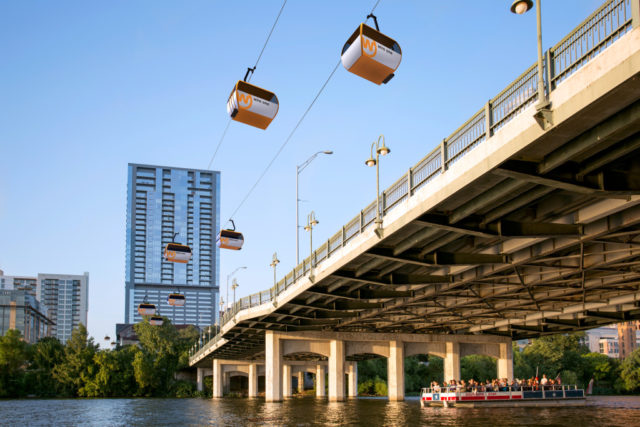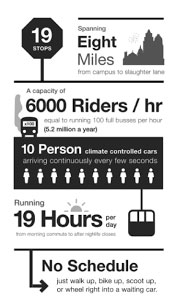Up in the Air: Urban Cable and the Future of Mobility
October 31, 2016 — Blog
From autonomous vehicles to mobility as a service, there has been an explosion in new technologies that will redefine how we move through cities. In the mix of these more digital innovations sits the more mechanical technology of urban cable.
Urban cable is the modernization of the gondola. Not the canal faring boats of Venice, but cabins ferrying urbanites on a cable supported on towers overhead. Perfected by the ski industry, high-speed detachable gondolas have now been engineered and deployed in urban environments as successful mass transportation systems. Using the “second story” of a city, urban cable has the capability to utilize areas once thought to be unserviceable. Until now, fast-growing cities were limited to high-cost, infrastructure-heavy alternatives like subways or light rail.

Just look to the famous example of Medellín, Colombia’s groundbreaking Metrocable and you immediately see the efficacy these systems can provide urban commuters. Over the past few years, the potential of urban cable to redefine transportation in congested cities worldwide has become increasingly feasible. But why hasn’t it been widely adopted?
Two major reasons are familiarity and perception. Most of us have encountered cable lines at ski areas, which gives the impression that anything gondola is just a toy for tourism. But urban cable engineering is far more sophisticated than your average ski gondola. Many haven’t experienced the promise of major urban cable commuter lines because they are located less well traveled cities like the Metrocable in Caracas, Venezuela, which integrates with rail and bus, or the Constantine Telepherique in Algeria, which carries 3 million riders a year.
At argodesign, the design consultancy team has unveiled a detailed concept for urban cable in our hometown of Austin, Texas. The proposal was well received by local officials, who have since agreed to fund a viability study, a first step toward a comprehensive feasibility review of the potential project. While ambitious and optimistic, urban cable may truly rise above Austin’s congested streets one day.
But how does urban cable technology fit into a modern urban transportation system?

Connecting Sustainable Districts
Today’s cities face the challenge of creating sustainable and connected neighborhoods that are often divided by natural geography or inflexible transit infrastructure. Cities also face challenges of increasing density when roadways are already overcrowded.
Cable cars suspended on towers can use the eminent domain above streets that belong to the city in order to add commuter capacity. It is an untapped opportunity. These same towers allow people to cross rivers, freeways and parks without the high costs or disruptions that arise from building bridges or tunnels. This key trait favors the adoption of urban cable in large- or medium-sized cities struggling with congestion but unable to afford major undertakings such as subway systems or other high-cost alternatives.
Matching Smart Transit to Smart Growth

While current mobility conversations center on autonomous vehicles and ridesharing, fixed-route transportation solutions seem incongruous. New car-centric options may not conclusively solve congestion problems. Thus it is essential to have a mix of mobility solutions that empower commuters with alternative options to get from point A to point B.
As modern cities grow denser and build vertically in an attempt to achieve smart and sustainable growth, urban cable could be the perfect tool to connect two walkable districts without adding to car congestion. Mike Deiparine from the Engineering Specialties Group described the capacity of urban cable as equal to running 50 buses per hour in each direction. Picture 3,000 people, per hour, in each direction. Imagining all those buses on a congested street helps you realize the impact that urban cable offers. What’s more, while buses run on a schedule, urban cable runs continuously.
Investors considering urban cable for the first time see value in the continuous operation of transportation as it fits neatly into routing data. The ability to easily gather and link transit data such as schedules and transport capacity can help urban planners model more realistic traffic patterns, travel times, emergency routes, and better predict the need and location of new infrastructure. Urban cable adds capacity that actually clears the road, creating space for ad hoc on-demand car systems.
There Are Some Barriers to Adoption
So why aren’t urban cable systems getting off the ground in every North American city? There is no single answer, rather it is a convergence of issues.
As I mentioned earlier, public officials lack critical technological knowledge about urban cable. Secondly, the industry has no lobby group to promote the benefits and hold a seat at the transportation policy table. Without it, there is a huge risk that urban cable will not get off the ground, literally.
By far the biggest impediment to change is transportation funding. While these systems cost much less than many other technologies, they do not yet qualify for matching dollars in the United States or Canada, whereas light and surface rail do. Private investment is an option for those developing large districts, but tapping into a city’s eminent domain requires a fair amount of private-public cooperation in order to succeed.
Even though urban cable technology often deploys at half the cost, matching funds are still important for North American cities – not just for the funding itself, but for the validation that comes with it. Urban cable is taking a hit in both loss of public funds and the would-be private investors seeing no public backing in place. Without an organized lobby promoting the benefits of urban cable and ensuring it is included in important transportation bills, there is a huge risk that urban cable won’t get off the ground, quite literally.
All it takes is one example successful example to demonstrate the possibilities. While novelty may entice people to test ride, a successful pilot system designed for cable-powered mass transit will be crucial to changing minds and to secure necessary funding and policy support. The East River Skyway proposal to connect Brooklyn and Manhattan, led by Dan Levy, may just become the first pilot line for North America. And in 2021 Greater Paris plans to a major urban cable system – the Televal gondola, covering 14.4 kilometers from suburban Paris to the southeastern city limits.
The enthusiasm around this emerging urban technology is growing. More urban cable proposals are being revealed in North America every day. It is only a matter of time before people see the positive impact it can have and before commuting on the second story of cities becomes a daily reality.